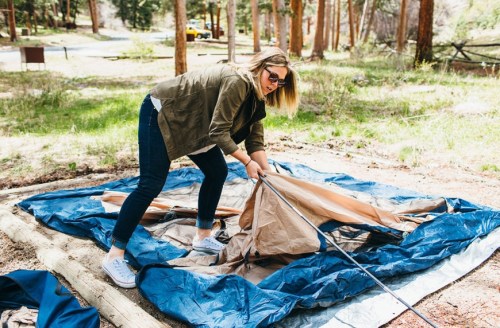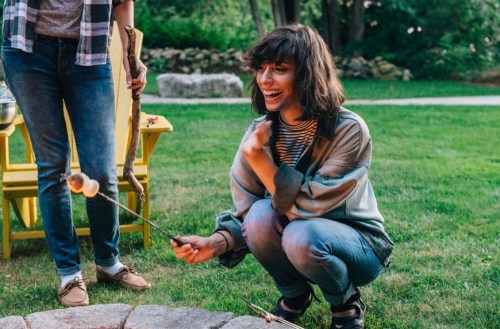Our editors independently select these products. Making a purchase through our links may earn Well+Good a commission
How to embrace camping when you’re the opposite of outdoorsy
Want to escape the city and give camping a try? Here's everything you need to know before you go—from must-have gear to meal ideas and campfire-building techniques.

Real talk: I am not “one with Mother Nature,” as they say. The thought of roughing it in the woods—sans hot water and a comfy bed, but with plenty of mosquitoes—is not what I daydream about when envisioning vacation. (Hello, Tulum!)
But when a group of friends suggested a restorative long weekend at a campground, the thought of escaping the stuffy subways while breathing in some fresh air suddenly didn’t seem like the worst idea in the world. Plus, there’s something about stargazing that really does it for me.
But as a newbie, embarking on an Earth-goddess adventure required a lesson on the ins and outs of the outdoors. So I turned to Marnie Hanel and Jen Stevenson, camping vets and authors of The Campout Cookbook: Inspired Recipes for Cooking Around the Fire and Under the Stars. “Camping will inspire you to completely unplug and settle into the peace and quiet of nature,” Hanel says. Okay, now I’m definitely interested.
Here’s how to make your first camping experience a memorable—and comfortable—one.

What to bring on a camping trip
First, the essentials. Hanel and Stevenson recommend packing the following “can’t-camp-without” items:
- Tent
- Sleeping bag
- Pillow
- Travel-sized toiletries
- Sharp knife
- Cutting board
- Cooler
- Rimmed baking sheets for ferrying food to and from the fire
- Metal mixing bowls
- Mason jars for food storage
- Mesh laundry bag to air-dry dishes
- Tinfoil for cooking
- BBQ tongs
- Heat resistant gloves
- Dish soap
- Towels
- Bug spray
- First-aid kit
- Wine opener
- Booze and chocolate (Be sure to check the alcohol regulations for your campsite first.)
If this version of “roughing it” sounds a little bit too rough for your liking, you can also feel free to bring along some decorations (think outdoor throw pillows or battery-powered string lights) to make your site your own. “We even bring enamelware, a pretty tablecloth, and stemless glasses to really feel like we have all the comforts of home,” Stevenson says.
And what about clothes? Pack a broken-in pair of hiking boots for activities and Birkenstocks for lounging. And don’t forget layers—the forecast can change fast, so you need to prepare for all the possible weather elements.
How to sleep well under the stars
When people say they don’t like camping, what they likely mean is they don’t like sleeping on rocks and roots—and who would? For beginners, Stevenson and Hanel recommend channeling a safari camp rather than a backpacker’s setup. Try raising your bed off the ground with a camp cot, or even bring an air mattress and a down comforter from home for extra comfort. (Pro tip: Choose a campground with drive-in sites rather than hike-in. If your car is right there, you can pack more gear and easily access it.)
It’s also important to research facilities when picking a campground. “Not all campground bathrooms are created equal, and not all campground toilets flush, so if you’re averse to that, be sure to book a campground with flush toilets and showers,” Hanel says.

Camp cooking 101
Just because you’re sleeping in the woods doesn’t mean you have to live off the land. The most basic camp cooking tool you’ll need is a two-burner Coleman camp stove, which Stevenson and Hanel recommend due to its light weight and simplicity. Just make sure you pack enough propane. (Or, if you’re feeling extra adventurous, you can buy wood at the campground store and try cooking over fire.)
When it comes to menu planning, the authors suggest prepping everything at home first. Season fish, poultry, and veggies with salt, pepper, and olive oil, and wrap them into tinfoil packets. (Just leave a couple inches of room above the ingredients.) When it’s time to cook, place the packets on your heat source and the ingredients will steam. You can also bring a cast-iron skillet and use it to stir-fry, either over the fire or on your camp stove.
The authors also recommend investing in a lightweight grill basket, which is great for cooking fish, vegetables, and even fruit. Try lightly grilling halved stone fruit (peaches, plums) or rings of pineapple for a simple, healthy dessert.
Another tool that’s hard to pack—but could be great to have on hand if cooking is your jam—is a Dutch oven. Stevenson and Hanel love it for chicken. Rub boneless chicken parts with paprika at home and wrap in tinfoil. At the campsite, toss the pieces into a hot Dutch oven, add root vegetables and herbs midway through roasting, and serve.

How to make a campfire
After dinner comes everyone’s favorite part—a roaring campfire session, complete with fire-roasted treats and ghost stories. (Or ghosting stories—arguably just as scary.)
A fool-proof campfire requires 3 basic elements: tinder (twigs, bark, dry leaves and grass, or newspaper); kindling (slim sticks roughly the diameter of a carrot), and firewood. Pile tinder in the middle of your fire pit, arrange kindling in a cone around it, then make a second “teepee” of firewood around that. Light the tinder and you’re in business. Just make sure everything is very dry. If anything is even semi-wet, you’ll get a lot of smoke. (Oh, and If you’re having trouble, potato chips and dried orange peels can help get the fire roaring—strange, but true.)
Stevenson and Hanel also recommend going gourmet with your s’mores ingredients. Here are a few of their favorite combos:
- S’moreos: Oreo cookies, hot fudge sauce, sprinkles, marshmallows
- S’mocolates: Tate’s chocolate chip cookies, cherry jam, crushed smoked almonds, marshmallows
- S’mackers: cinnamon graham crackers, peanut butter cups, banana slices, marshmallows

Still sounds like too much work? Give glamping a go
You’ve likely heard of “glamping”—AKA glamorous camping. Basically this means you’re sleeping outside, but usually in luxury tents with resort style amenities that take all the hassle out of camping. (No tent maintenance, no midnight bathroom runs, on-site restaurants, and someone who’s happy to build the campfire for you? Score.)
Some choice places to glamp include California’s Ventana Big Sur,Capitol Reef Resort in Utah (perk: you sleep in Oregon Trail style wagons!),Dunton River Camp in Colorado,The Resort at Paws Up in Montana, and Collective at Governors Island in New York City. Hanel and Stevenson also recommend Shelter Co., a curator of outdoor experiences, which sets up overnight digs in gorgeous locations. All you have to do is show up.
Kicking it in nature is more than just fun—it can even boost your health. And here are 5 easy ways to bring nature indoors.
Sign Up for Our Daily Newsletter
Get all the latest in wellness, trends, food, fitness, beauty, and more delivered right to your inbox.
Got it, you've been added to our email list.








